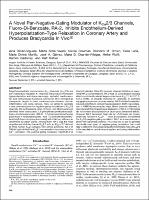Please use this identifier to cite or link to this item:
https://repositorio.usj.es/handle/123456789/517
| Title: | A Novel Pan-Negative-Gating Modulator of K(Ca)2/3 Channels, Fluoro-Di-Benzoate, RA-2, Inhibits Endothelium-Derived Hyperpolarization-Type Relaxation in Coronary Artery and Produces Bradycardia In Vivo |
| Authors: | Olivan-Viguera, Aida


Valero Gracia, Marta Sofía 


Coleman, Nichole 
Brown, Brandon M. 

Laria Campaña, Celia Murillo, Mª Divina 


Gálvez, José Antonio 

Díaz-de-Villegas, María Dolores 

Wulff, Heike 

Badorrey, Ramón 

Köhler, Ralf 

|
| Keywords: | CA2+-ACTIVATED K+ CHANNEL; ACTIVATED POTASSIUM CHANNELS; SMALL-CONDUCTANCE; K(CA)3.1; ATRIAL; SKA-31; SK3; EXPRESSION; PHARMACOLOGY; CONTRIBUTES |
| Issue Date: | Feb-2015 |
| Publisher: | AMER SOC PHARMACOLOGY EXPERIMENTAL THERAPEUTICS |
| Citation: | Oliván-Viguera, A., Valero, M.S., Coleman, N., Brown, B.M., Laría, C., Divina Murillo, M., Gálvez, J.A., Díaz-De-Villegas, M.D., Wulff, H., Badorrey, R., Köhler, R., 2015. A Novel Pan-Negative-Gating Modulator of KCa2/3 Channels, Fluoro-Di-Benzoate, RA-2, Inhibits Endothelium-Derived Hyperpolarization–Type Relaxation in Coronary Artery and Produces Bradycardia In Vivo. Molecular Pharmacology 87, 338–348.. doi:10.1124/mol.114.095745 |
| Abstract: | Small/intermediate conductance K-Ca channels (K(Ca)2/3) are Ca2+/calmodulin regulated K+ channels that produce membrane hyperpolarization and shape neurologic, epithelial, cardiovascular, and immunologic functions. Moreover, they emerged as therapeutic targets to treat cardiovascular disease, chronic inflammation, and some cancers. Here, we aimed to generate a new pharmacophore for negative-gating modulation of K(Ca)2/3 channels. We synthesized a series of mono-and dibenzoates and identified three dibenzoates [1,3-phenylenebis(methylene) bis(3-fluoro-4-hydroxybenzoate) (RA-2), 1,2-phenylenebis(methylene) bis(3-fluoro-4-hydroxybenzoate), and 1,4-phenylenebis(methylene) bis(3-fluoro-4-hydroxybenzoate)] with inhibitory efficacy as determined by patch clamp. Among them, RA-2 was the most drug-like and inhibited human K(Ca)3.1 with an IC50 of 17 nM and all three human K(Ca)2 subtypes with similar potencies. RA-2 at 100 nM right-shifted the K(Ca)3.1 concentration-response curve for Ca2+ activation. The positive-gating modulator naphtho[1,2-d]thiazol-2-ylamine (SKA-31) reversed channel inhibition at nanomolar RA-2 concentrations. RA-2 had no considerable blocking effects on distantly related large-conductance K(Ca)1.1, Kv1.2/1.3, Kv7.4, hERG, or inwardly rectifying K+ channels. In isometric myography on porcine coronary arteries, RA-2 inhibited bradykinin-induced endothelium-derived hyperpolarization (EDH)-type relaxation in U46619-precontracted rings. Blood pressure telemetry in mice showed that intraperitoneal application of RA-2 (<= 100 mg/kg) did not increase blood pressure or cause gross behavioral deficits. However, RA-2 decreased heart rate by approximate to 145 beats per minute, which was not seen in K(Ca)3.1(-/-) mice. In conclusion, we identified the K(Ca)2/3-negative-gating modulator, RA-2, as a new pharmacophore with nanomolar potency. RA-2 may be of use to generate structurally new types of negative-gating modulators that could help to define the physiologic and pathomechanistic roles of K(Ca)2/3 in the vasculature, central nervous system, and during inflammation in vivo. |
| URI: | https://repositorio.usj.es/handle/123456789/517 |
| ISSN: | 1521-0111 |
| Appears in Collections: | Artículos de revistas |
Files in This Item:
| File | Description | Size | Format | |
|---|---|---|---|---|
| A Novel Pan-Negative-Gating Modulator of KCa23 Channels.pdf | 1,61 MB | Adobe PDF |  View/Open |
This item is licensed under a Creative Commons License

